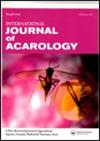通过社交媒体发现的另一种螨虫——Ameronothrus retweet sp. 11 .(蜱螨,甲螨)来自日本海岸,表现出有趣的两性异形
IF 1
3区 农林科学
Q3 ENTOMOLOGY
引用次数: 2
摘要
摘要最近,通过社交媒体平台在推特上发现了甲螨Ameronothrus,引起了媒体的强烈反响,并提高了公众对这些微小生物的认识。直接的结果是,现在通过同一社交媒体服务发现了另一种与海洋相关的新ameronotroid物种。此外,这一新物种Ameronothrus retweet sp.n的记录代表了来自日本海海岸的第一个Ameronothoid分类单元的报告,表明该海岸线被这些生物成功地定殖,并且可能存在更多的物种。Ameronothrus retweet sp.n.表现出非凡的两性异形,雌性具有相对较短的腿和强烈折叠的脊骨被膜。根据形态特征,认为该新种与线纹Ameronothrus lineatus和黑鳍Ameronothus nigroferatus亲缘关系最为密切。使用18S rRNA基因对选定的ameronothoid分类群进行的分子遗传学研究表明,所有Ameronothrus物种都有密切的亲缘关系,并代表一个独特的单系属。在更大的系统发育背景下,Fortuynidae和Selenoribatidae被认为是具有单系起源的姐妹分类群,而Ameronothridae的某些成员被置于副系位置,这支持了ameronthroid螨海洋相关生活方式独立起源的理论。http://www.zoobank.org/urn:lsid:zoobank.org:pub:D0D9B80E-D144-436D-82B1-F2847178E861http://www.zoobank.org/urn:lsid:zoobank.org:act:0CFB4401-1EC4-4BB8-97CD-13812FF11D83本文章由计算机程序翻译,如有差异,请以英文原文为准。
Another mite species discovered via social media - Ameronothrus retweet sp. nov. (Acari, Oribatida) from Japanese coasts, exhibiting an interesting sexual dimorphism
ABSTRACT The recent discovery of the oribatid mite Ameronothrus twitter via a social media platform resulted in a considerable media response and raised the awareness of the public for these tiny organisms. As a direct consequence, another new marine associated ameronothroid species was now discovered via the same social media service. Moreover, the record of this new species, Ameronothrus retweet sp. n., represents the first report of an ameronothroid taxon from the Sea of Japan coast, indicating that this coastline was successfully colonized by these organisms and that further species could be present there. Ameronothrus retweet sp. n. shows an extraordinary sexual dimorphism with females having relatively shorter legs and a strongly folded notogastral integument. Based on morphological characteristics, it is suggested that the new species is closest related to Ameronothrus lineatus and Ameronothrus nigrofemoratus. A molecular genetic investigation of selected ameronothroid taxa, using the 18S rRNA gene, shows that all Ameronothrus species are closely related and represent a distinct monophyletic genus. In a larger phylogenetic context, the Fortuyniidae and Selenoribatidae are given as sister taxa with a monophyletic origin, whereas certain members of Ameronothridae are placed in paraphyletic positions, supporting theories of an independent origin of the marine associated lifestyle in ameronothroid mites. http://www.zoobank.org/urn:lsid:zoobank.org:pub:D0D9B80E-D144-436D-82B1-F2847178E861 http://www.zoobank.org/urn:lsid:zoobank.org:act:0CFB4401-1EC4-4BB8-97CD-13812FF11D83
求助全文
通过发布文献求助,成功后即可免费获取论文全文。
去求助
来源期刊
CiteScore
2.20
自引率
9.10%
发文量
60
审稿时长
6-12 weeks
期刊介绍:
The International Journal of Acarology has a global readership and publishes original research and review papers on a wide variety of acarological subjects including:
• mite and tick behavior
• biochemistry
• biology
• control
• ecology
• evolution
• morphology
• physiology
• systematics
• taxonomy (single species descriptions are discouraged unless accompanied by additional new information on ecology, biology, systematics, etc.)
All submitted manuscripts are subject to initial appraisal by the Editor. If the English is not of a quality suitable for reviewers, the manuscript will be returned. If found suitable for further consideration, it will be submitted to peer review by independent, anonymous expert referees. All peer review is single blind.

 求助内容:
求助内容: 应助结果提醒方式:
应助结果提醒方式:


